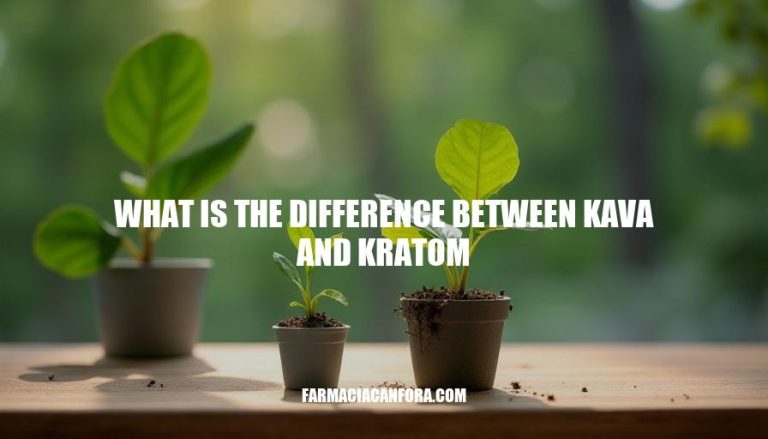Kava and kratom are two popular herbal supplements, but they come from different plants and have distinct effectsKava is derived from the root of the Piper methysticum plant, native to the Pacific Islands, and is known for its calming and relaxing propertiesKratom, on the other hand, comes from the leaves of the Mitragyna speciosa tree, native to Southeast Asia, and can act as both a stimulant and a sedative depending on the dose.
Understanding the differences between kava and kratom is crucial because they affect the body in unique ways and have different safety profiles. This knowledge helps users make informed decisions about which supplement might be best suited for their needs.
Origins and Botanical Classification
Kava (Piper methysticum) is a plant from the pepper family, native to the Pacific Islands, including Fiji, Vanuatu, and Hawaii. It is traditionally used to prepare a calming beverage from its roots, known for its sedative and anxiolytic properties.
Kratom (Mitragyna speciosa) belongs to the coffee family and is native to Southeast Asia, particularly Thailand, Indonesia, and Malaysia. The leaves of the kratom tree are used for their stimulant and sedative effects, depending on the dosage.
Geographical and Biological Differences:
- Kava: Originates from the Pacific Islands; part of the pepper family.
- Kratom: Originates from Southeast Asia; part of the coffee family.
Chemical Composition
Kava and kratom are both natural substances with distinct chemical compositions and effects.
Kava:
- Active Compounds: Kava contains kavalactones, which are the primary active compounds. The six major kavalactones are kavain, dihydrokavain, methysticin, dihydromethysticin, yangonin, and desmethoxyyangonin.
- Effects: These kavalactones primarily affect the central nervous system, promoting relaxation, reducing anxiety, and producing sedative effects.
Kratom:
- Active Compounds: Kratom’s primary active compounds are alkaloids, with mitragynine and 7-hydroxymitragynine being the most notable.
- Effects: These alkaloids interact with the brain’s opioid receptors. At lower doses, kratom acts as a stimulant, increasing energy and alertness. At higher doses, it has sedative effects, providing pain relief and relaxation.
In summary, kava’s kavalactones are mainly sedative and anxiolytic, while kratom’s alkaloids can be both stimulating and sedative, depending on the dosage.
Effects and Uses
Kava and kratom are both natural substances with distinct effects and uses:
Kava
- Effects: Kava primarily produces calming and relaxing effects. It contains kavalactones, which interact with the central nervous system to reduce anxiety and promote relaxation without causing sedation.
- Uses: Commonly used for its anxiolytic properties, kava is often consumed to alleviate stress, anxiety, and insomnia. It is also used in social and ceremonial contexts in Pacific Island cultures.
Kratom
- Effects: Kratom’s effects vary with dosage. At lower doses, it acts as a stimulant, increasing energy and alertness. At higher doses, it has sedative and analgesic effects due to its active compounds, mitragynine and 7-hydroxymitragynine, which interact with opioid receptors.
- Uses: Kratom is used for pain relief, managing opioid withdrawal symptoms, and as a stimulant to combat fatigue.
Key Differences
- Impact on the Body: Kava induces relaxation and reduces anxiety without significant sedation, while kratom can either stimulate or sedate depending on the dose.
- Applications: Kava is mainly used for anxiety and stress relief, whereas kratom is used for pain management, energy boosting, and opioid withdrawal support.
Legal Status
Kava:
- United States: Legal at the federal level and widely available.
- European Union: Generally legal, but some countries have restrictions.
- Australia: Legal but regulated; requires a prescription in some states.
- New Zealand: Legal with restrictions on sales and advertising.
- Canada: Legal but regulated as a natural health product.
Kratom:
- United States: Legal at the federal level but banned in several states (e.g., Alabama, Arkansas, Indiana, Rhode Island, Vermont, Wisconsin) and some local jurisdictions.
- European Union: Banned in several countries (e.g., Denmark, Finland, Poland, Sweden).
- Australia: Classified as a controlled substance; illegal to possess or sell.
- New Zealand: Classified as a controlled drug; illegal without a prescription.
- Canada: Not approved for sale; Health Canada advises against its use.
Key Differences:
- Kava is generally more widely accepted and legal in many regions, often regulated as a natural health product.
- Kratom faces stricter regulations and is banned in more regions due to its opioid-like effects and potential for abuse.
Safety and Side Effects
Kava
- Safety: Generally considered safe when used in moderation.
- Side Effects: Can cause gastrointestinal discomfort, dizziness, and potential liver toxicity, especially with excessive use or when combined with other liver-damaging substances.
Kratom
- Safety: Associated with significant safety concerns.
- Side Effects: Includes nausea, constipation, dizziness, weight loss, insomnia, sweating, and potential liver toxicity. Long-term use can lead to dependence and withdrawal symptoms.
Key Differences
- Kava: Primarily affects the central nervous system, promoting relaxation and reducing anxiety. Risks are mainly related to liver health.
- Kratom: Interacts with opioid receptors, producing stimulant or sedative effects depending on the dose. It carries higher risks of addiction, dependence, and a broader range of adverse effects.
Kava and Kratom: Understanding the Differences
Kava and kratom are two distinct herbal supplements with different origins, effects, and uses. Kava is derived from the root of the Piper methysticum plant, native to the Pacific Islands, while kratom comes from the leaves of the Mitragyna speciosa tree in Southeast Asia.
Differences in Effects and Safety Profiles
Understanding their differences is crucial for informed decision-making due to their unique interactions with the body and varying safety profiles. Key points include:
- Kava’s kavalactones primarily induce relaxation and reduce anxiety without significant sedation, whereas kratom’s alkaloids can stimulate or sedate depending on the dose.
- Kratom carries higher risks of addiction, dependence, and adverse effects compared to kava.
Legal Status and Regulation
The legal status of these substances varies globally, with kava being more widely accepted and regulated as a natural health product, while kratom faces stricter regulations and is banned in several regions.
Ultimately, recognizing the differences between kava and kratom empowers users to make informed choices about their use.


